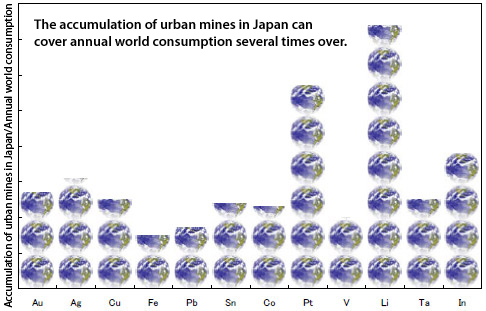Japan’s “Urban Mines” are Comparable to the World’s Leading Resource Nations
Calculating the Scale of the Urban Mines Accumulated in Japan
2008.01.11
National Institute for Materials Science
The National Institute for Materials Science calculated the amount of metals which have been accumulated in Japan to date which are recyclable for use as metal resources in the future.
Abstract
- Amid concern about future shortages of metals, Dr. Kohmei Harada, Managing Director of the Innovative Materials Engineering Laboratory, who is also Manager Director of the Strategic Use of Elements Interdisciplinary Cluster at the National Institute for Materials Science (President: Teruo Kishi), calculated the amount of metals which have been accumulated in Japan to date which are recyclable for use as metal resources in the future. These metals, called “urban mines”, are found in a wide range of products, but are generally not recycled when products are discarded. The results of this study revealed that Japan’s urban mines have reached a scale comparable to natural reserves of the world’s leading resource nations.
- According to these calculations, Japan’s urban mines of many metals exceed 10% of world reserves, including gold, (approx. 6,800 tons, or about 16% of the world’s current reserves of 42,000 tons), silver (60,000 tons, or 22%), indium (61%), tin (11%), and tantalum (10%). Many other metals, including platinum, also rank in the top 5 in comparison with reserves by country.
- These calculations are based on trade statistics, which are data on imports and exports with other countries. However, basic materials are frequently imported or exported in the form of parts or products. In particular, because Japan is a major exporter of products, overestimation of urban mines is possible if the amount of basic materials exported in the form of products is not taken into account. Therefore, in these calculations, the percentages of basic materials exported in parts and products were estimated using related industry data, this percentage was multiplied by demand for materials for parts, etc. obtained from industry statistics, and the resulting outflow to other countries in products was subtracted to obtain the total in Japan.
- At present, these domestic urban mine resources are also discharged at less than the essential value which could be realized by the waste treatment of the accompanying materials in the disposal of used products. In contrast to this, a more active method of effective utilization of urban mine resources as urban ores is necessary, enabling export or use as high grade concentrates, like those produced from crude ores at natural mines.
- The results of this study will be presented in poster sessions at the Recycling Society Regional Symposium to be held by the Research Institute of Science and Technology for Society (RISTEX) of the Japan Science and Technology Agency (JST) on January 15, and will also be presented at the Spring Meetings of the Iron and Steel Institute of Japan and the Mining and Materials Processing Institute of Japan in March.

Accumulation of urban mines in Japan/Annual world consumption
- Previous
- Back to List
- Next
